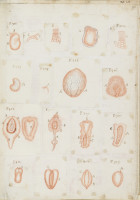Plant seeds
Date
1675
Creator
Unknown, Engraver
After
Marcello Malpighi (1628 - 1694, Italian) , Biologist
Object type
Library reference
54269
Material
Dimensions
height (page): 362 mm
width (page): 231mm
height (plate): 310mm
width (plate): 217mm
width (page): 231mm
height (plate): 310mm
width (plate): 217mm
Subject
Description
Sectional views of various impregnated plant seeds viewed under magnification, including:
Figure 301 and 311 [upper left and lower left]: Bean, Phaseolus, referred to by Malpighi as Fabis.
Figure 302 [upper right]: Pea, Pisum sativum, referred to as Pisis.
Figure 303 [centre left]: White poppy, Papaver, referred to as Papaveris albi.
Figure 304 [centre left]: Almond tree, Prunus amygdalus, referred to as Amygdalarum.
Figure 305 [centre]: Hemp, Cannabis sativa cultivars, referred to as Cannabe.
Figure 306 [centre right]: Purslane, Portulaca oleracea, and hyacinth, Hyacinthus, referred to as Portulaca and Hyacintho respectively.
Figure 307 [centre left]: Green bean, Phaseolus vulgaris, referred to as Faseolis.
Figure 308 and 309 [centre left and right]: Chickpea, Cicer arietinum, referred to as Cicercula.
Figure 310 [centre right]: Lupine, Lupinus, referred to as the same.
Figure 312 and 313 [lower right]: Millet, Pennisetum glaucum, referred to as Milii solis.
Inscribed: ‘Tab LII’ in top right-hand corner.
Table 52 from Marcello Malpighi's Anatome plantarum; cui subjungitur Appendix […] (1675).
Marcello Malpighi (1628-1694), Italian biologist and physician, was elected a Fellow of the Royal Society in 1669.
Figure 301 and 311 [upper left and lower left]: Bean, Phaseolus, referred to by Malpighi as Fabis.
Figure 302 [upper right]: Pea, Pisum sativum, referred to as Pisis.
Figure 303 [centre left]: White poppy, Papaver, referred to as Papaveris albi.
Figure 304 [centre left]: Almond tree, Prunus amygdalus, referred to as Amygdalarum.
Figure 305 [centre]: Hemp, Cannabis sativa cultivars, referred to as Cannabe.
Figure 306 [centre right]: Purslane, Portulaca oleracea, and hyacinth, Hyacinthus, referred to as Portulaca and Hyacintho respectively.
Figure 307 [centre left]: Green bean, Phaseolus vulgaris, referred to as Faseolis.
Figure 308 and 309 [centre left and right]: Chickpea, Cicer arietinum, referred to as Cicercula.
Figure 310 [centre right]: Lupine, Lupinus, referred to as the same.
Figure 312 and 313 [lower right]: Millet, Pennisetum glaucum, referred to as Milii solis.
Inscribed: ‘Tab LII’ in top right-hand corner.
Table 52 from Marcello Malpighi's Anatome plantarum; cui subjungitur Appendix […] (1675).
Marcello Malpighi (1628-1694), Italian biologist and physician, was elected a Fellow of the Royal Society in 1669.
Object history
Anatome Plantarum was a much-anticipated work and, along with Nehemiah Grew FRS (1641-1712), earned Malpighi acclaim as founder of the microscopic study of plant anatomy.
His research was encouraged and supervised by the Royal Society, as evidenced by correspondence between him and the then-Secretary, Henry Oldenburg FRS (1619-1677) in the 1660s and 1670s [MS/103/1]. An abstracted version of his work in this area was first read at a Society meeting on 7 December 1671 [JBO/4, pp.216-217]. The full manuscript of Anatome Plantarum, together with the frontispiece artwork and these plates, was received and read on 28 January 1674/75 [MS/103/1-2].
It was ordered for printing by the Society’s printer John Martin in June 1675 [CMO/1/221]. The published work consists of the text of Anatome Plantarum, De ovo incubato, and 61 plates illustrating each [54 and 7 respectively]. A second part was sent by Malpighi to the Society in 1678 and published in 1679 as Anatomes plantarum pars altera [54271].
His research was encouraged and supervised by the Royal Society, as evidenced by correspondence between him and the then-Secretary, Henry Oldenburg FRS (1619-1677) in the 1660s and 1670s [MS/103/1]. An abstracted version of his work in this area was first read at a Society meeting on 7 December 1671 [JBO/4, pp.216-217]. The full manuscript of Anatome Plantarum, together with the frontispiece artwork and these plates, was received and read on 28 January 1674/75 [MS/103/1-2].
It was ordered for printing by the Society’s printer John Martin in June 1675 [CMO/1/221]. The published work consists of the text of Anatome Plantarum, De ovo incubato, and 61 plates illustrating each [54 and 7 respectively]. A second part was sent by Malpighi to the Society in 1678 and published in 1679 as Anatomes plantarum pars altera [54271].
Associated place
